|
This
is N6NB (then K6YNB) at age 14 in late 1957 at my first station.
It used only vacuum tubes for all functions. The Heathkit DX35
transmitter was crystal controlled and used controlled carrier for AM
until that system was replaced by an outboard high-level plate
modulator. The item at the center was a preselector that
greatly improved the Heathkit AR-3 receiver's performance, especially
on 15 and 10 meters. The modulator and preselector were
homebrew items built with mostly surplus components, which were
plentiful after World War II. The modulator used 6L6 tubes in a
push-pull circuit.
HAM
RADIO SINCE 1957: AN EYEWITNESS ACCOUNT
1
This is a story about the
hobby of amateur radio, written for both licensed "hams"
and others. I'll try to define jargon when I use it and explain
processes as clearly as possible.
I've taken on this endeavor to share some of what I've seen in my 68
years of ham radio. I was first licensed at age 14 in 1957.
Ham radio itself is amateur.
No business activity by hams using amateur radio frequencies is
allowed, although many use the skills they learned as hams to gain
employment in profit-seeking endeavors. What constitutes
business activity is often disputed.
The use of the term "ham
radio" can be tracked back more than 100 years, although there
is disagreement about how amateur radio operators came to be called
"hams". There are about 700,000 licensed amateur
radio operators in the United States, although fewer than half of
them are on the air. All have call signs.
Since the postwar era began, amateur radio call signs have been based
on the person's class of license. At first I held a non-renewable
novice class license (since abolished). My first call was
KN6YNB. When I passed the exam for a general class license, the
"n" was dropped and I became K6YNB under policies of the
Federal Communications Commission (FCC). Later I passed the
extra class license exam. That was good timing because the
FCC's first-ever vanity call sign program in 1977 was only for extra
class licensees (until then call signs were assigned in alphabetical
order). I asked for and was given N6NB. Now the FCC has
a vanity call sign program under which any licensee may apply for any
available call sign for which he/she is eligible by license class.
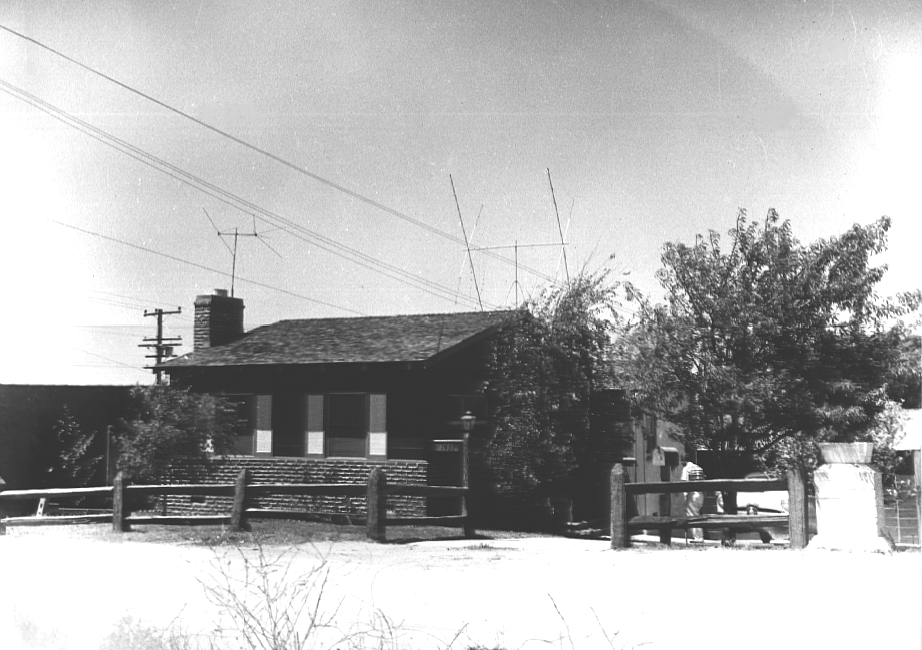
The FCC issues call
signs to on-the-air broadcasters, "land mobile" systems
(for example, a fleet of trucks), aircraft owners and many others who
are authorized to transmit a radio or television signal on the air.
Cable television networks do not transmit over the air and are only
indirectly regulated by the FCC, freeing them from many federal
regulations including restrictions on their language and content.
When I got on the air in 1957,
ham radio was dominated by veterans who had seen buddies killed in
combat but also learned about radio in the military. World War
II had ended less than 12 years earlier and the Korean War ended not
even four years earlier. The veterans were called "the
greatest generation" in a book title by award-winning television
journalist Tom Brokaw. A few members of "the greatest
generation" had little sympathy for naive teen-agers like
me who were trying to learn from them at radio club meetings in smoky
rooms. In those days many places were smoky, including
workplaces, restaurants and airplane cabins. The surgeon
general's report linking smoking to lung cancer didn't come until
nearly two decades later. Fortunately, ham radio
operators were (and still are) known for their concept of "elmering"
(helping beginners). (Caption
for the picture at right: This is where I lived in the late
1950s, notable not only for the cubical quad antenna but also because
the street was unpaved. Many east Manhattan Beach streets
were not paved until 1959 or 1960).
WAR
STORIES
In the early postwar era, there were many war stories circulating. One of the best, I think, was about a wartime incident in the South Pacific. An American unit was looking for individual Japanese soldiers who could be captured and questioned. An American who happened to be a ham radio operator back home (although hams were forbidden to transmit during the war) managed to surprise and tackle a Japanese soldier. As the soldier went down, a copy of "QST", the magazine published by ARRL, the national association of U.S. ham radio operators, fell out of his pocket. One of the first things the American asked the now-captured Japanese soldier was if he had a call sign. In good English, the Japanese man gave a call sign that was consistent with the prewar call-sign policies in Imperial Japan. Some versions of this story say the American and the Japanese man had "worked" (contacted) each other before the war. That they would remember such a contact in the middle of a war struck me as unlikely. Granted, U.S. hams had made numerous overseas contacts before the war, but most of those were by the impersonal mode of "Morse" code, not by voice. Morse code was made famous for modern viewers by James Cameron's 1997 film, Titanic, which depicted the heroism of a Morse operator who remained on the air as the ship sank after hitting an iceberg.
ARRL was originally called the
American Radio Relay League and the acronym survived long after
relaying "radiograms" by Morse code ceased to be the
dominant interest of most hams.
By the time I got on the air
in 1957, Morse code was in decline everywhere except amateur radio,
Even among hams, the use of Morse tanked after the FCC and regulators
in many other countries dropped Morse testing from license exams.
The FCC dropped Morse because it was seen as irrelevant in this era
of high quality worldwide digital communications and satellites.
Ironically, those digital technologies also contributed to a decline
in the appeal of worldwide ham radio communications via Morse and
"phone" (voice). However, digital technology also
made the use of "WSJT" attractive to thousands of hams.
"WSJT" is a digital mode largely created by Dr. Joe Taylor
(K1JT), former provost at Princeton University and a Nobel laureate
in physics. It is distributed for free on Princeton's
website. It makes a home computer into a very sensitive digital
communications terminal. It has associated modes for uses such
as high speed meteor scatter (use of meteors entering the Earth's
atmosphere to create communications over paths of up to about 1,500
miles), and e.m.e. (earth-moon-earth or "moonbounce"
communications) by detecting weak signals reflected
off the moon's surface over paths of up to 500,000 miles round trip.
(Caption for picture
at left: this is what a good station looked like in 1967. Note
the Henry 2K legal limit amplifier, the Drake TR-3 SSB transceiver,
and the Hallicafters SX-101 receiver. My daughter was already
curious about ham radio before her first birthday.)
A
HAM RADIO VOYAGE THROUGH TIME
In my first year on the air I
used the prevailing modes of the day (Morse code and voice) with the
station shown in the photo. It was called a "novice"
station because such stations were often used by people who held the
FCC's novice license (since abolished) and were strapped for cash.
It was capable of spanning surprising distances, especially during
peaks of the 11-year solar sunspot cycle that enhances global
propagation. One of the best sunspot cycles ever, Cycle 19,
peaked in 1957-58. I was lucky, but I didn't know that
until later. The cycle numbers can be traced back to the 1700s,
when scientists first started counting sunspots and quickly
determined that there is an 11-year cycle of peaks and valleys.
It was discovered in the early 1900s that the solar sunspot peaks
correlate with dramatic improvements in long-distance radio
propagation.
After I passed the exam
for a general class license and was freed of the restrictions on the
use of voice by novices, I began to follow my friends who were also
former novices. Even back then ham radio fell into several
categories. Some loved "working DX" (making long
distance contacts) and would earn
DXCC (DX
Century Club, an award
granted by ARRL to those who contacted 100 countries and submitted
QSL cards from other
hams to
document their
achievement) before these young hams went off to
college.
\
DEFINITIONS,
CLUBS AND CONTESTS
One term that is often used in
this article is "MHz". It stands for megaHertz
and is named in honor of German physicist Heinrich Hertz, who proved
the existence of radio waves in the late 1800s.
By the 1950s, many hams
were not only excited about working DX but also operating in "radio
contests" sponsored by ARRL and other organizations. A
radio contest is an operating event in which hams try to contact as
many other stations in as many geographic entities as possible, with
their scores determined by multiplying their number of contacts by
the number of geographic entities ("multipliers").
Having a lot of multipliers results in a much higher score than would
be possible if the operator only sought to make contacts at a high
"rate", ignoring the effects of a low multiplier total.
Multipliers are usually geographic entities like countries or states.
In some VHF (very high
frequency) contests the multipliers are called "grid squares"
and they are one degree of latitude by two degrees of longitude in
size (about 60 by 120 miles in most of the U.S.) and become much
smaller near the north and south poles. Grid squares are mainly
used on the highest frequencies and the shortest wavelengths, like
six meters (50 MHz) , two meters (144 MHz) or 70 centimeters
(432 MHz). The higher the frequency, the shorter the wavelength
is. On a wavelength of 3 centimeters (10,000 MHz), any contact is
considered a technical achievement. At that frequency
multipliers are available that are unavailable to those who only have
lower frequencies. There is a microwave incentive built into
the rules for some contests, rewarding those who build reliable
equipment for the microwave bands with higher scores. Each
multiplier is counted on a given band and is counted again if the
operator contacts that grid square again on another band.
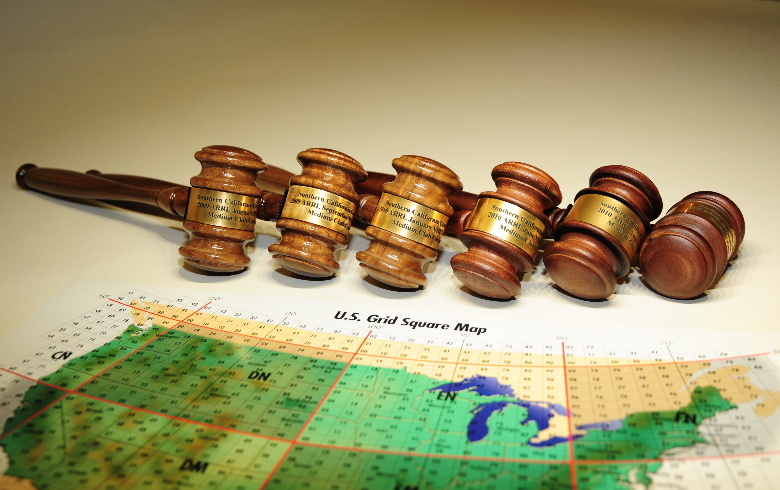
There are other details of
contest rules that can affect some hams' scores. Radio clubs
have been a major feature of ham radio since its beginning.
Clubs provide a place for hams to meet each other and plan for public
service events. They also host guest speakers on many topics.
I was a frequent guest speaker when I was an elected vice director of
ARRL. In many contests there is a club "aggregate"
competition in which all members can submit their scores to their
club's total score as well as having their scores listed individually
in the contest sponsor's results. This club competition is
hotly contested. Some clubs such as the Potomac Valley Radio
Club have dominated the club competition for years, fighting off
various challengers for top honors. In contests there are
categories including single operator (one licensed operator) and
multioperator (two or more licensed operators). Both are
eligible to participate in the club competition. (Caption
for picture at right: This is a grid square map with six
gavels won by the Southern California Contest Club in the club
competition.)
In addition to local and
regional clubs there are nationwide organizations such as ARRL in the
U.S. and RSGB (the Radio Society of Great Britain) in the U.K.
Almost all countries have such organizations. For example,
there is NZART (the New Zealand Association of Radio Transmitters)
and DARC (the Deutscher Amateur Radio Club) in Germany, among
many others. On top of all that, there are international
entities such as IARU (the International Amateur Radio Union).
All play a role in representing the interests of amateur radio at
worldwide conferences that determine how much of the radio spectrum
is left for amateur radio use. Those who oppose the hams are usually
powerful international companies that would leave almost none of the
spectrum to hobbyists.
REDUCING
THE TVI/RFI PROBLEM
In the 1950s there was a huge
problem that isn't even a minor problem for most modern-day radio
amateurs: TVI (television interference) and RFI (interference
to other electronic devices). When I got on the air in 1957,
dealing with angry neighbors was a daily reality. As a young
ham, I was an easy target. My 35-watt AM transmitter wiped out
neighbors' TV reception. Many people owned older TV sets with
21 MHz IFs (intermediate frequencies) that were great at picking up
signals on the 15-meter amateur band (also 21 MHz). At first I
was safer because novice hams were only allowed to use Morse code on
15 meters. But when I passed my general class license exam and
got on phone there was hell in the neighborhood. Irate
people formed mobs and stormed my house, terrifying my parents.
Several times bags of human excrement ruptured on the driveway.
Some called the local FCC office to complain. The FCC's
standard answer was that only TV sets of good engineering design were
protected from TVI from nearby hams--even young ones. That
infuriated my neighbors. In fairness to the neighbors, what they
heard and saw on their TV sets wasn’t pretty. There was garbled
audio that wiped out the sounds of a TV show while lines and bars
obliterated the picture.
A
few years later I moved to my own house to be closer to my first
college teaching job. I bought a tower and a kilowatt rig.
I was more conspicuous and the neighbors were even angrier. My
neighbors gathered at my door and circulated petitions to the FCC,
but advances in technology saved many hams, including me. Many
more TV sets were of good engineering design. In fact, both
receivers and transmitters got better. Many TV sets and other
home electronic devices became better at rejecting out-of-band (but
strong) local signals. Transmitters were filtered to suppress
spurious signals on frequencies used by broadcasters. A reality
that often went unspoken was that in the 1950s some transmitters had
excessive spurious signals on TV channels. Broadcasters also
migrated to higher frequencies further away from the most popular ham
bands when digital TV arrived. Cable systems with proper
shielding provided another barrier to TVI complaints. ARRL
staff members and the ARRL lab provided good support to hams.
The lab tested ham transmitters and
receivers, then
published the results. TVI became a footnote in the
history of ham radio, not a scourge.
EMCOMM
AND REPEATERS
Emergency communications (now
called "emcomm") was popular within amateur radio from its
early days. It involves hams using their portable radio
equipment (which has changed
from bulky to small)
to provide communications at the scene of fires, earthquakes,
hurricanes and
many other natural disasters. These days access to those events
is strictly regulated and hams often provide public service
communications at events such as bike races, marathons, and parades.
But when first responders' own radio networks and cellphones fail,
they may welcome help from hams, whose ham-to-ham communications are
so infrastructure-free that they function well when all else fails.
Today hams use low-power
hand-held radios with "rubber duck" antennas that only have
a short range, especially in cities and wooded areas. These
small radios would be almost useless without repeaters, often located
on mountaintops or tall buildings. Repeaters can hear weak
signals and retransmit them at much higher power and with
better antennas, extending the range from a few miles to an entire
metropolitan area. Despite their
value in emcomm,
repeaters are banned in most radio contests precisely because of
their range-extending capability. Those who have invested a lot
of time and money to build their own big stations do not want their
efforts nullified by small stations using repeaters. When
repeaters first moved from commercial users to hams in the 1950s
and 1960s
they were widely used to keep members of a club or community in
touch. Almost everyone wanted to have a repeater back then, but
over time activity dwindled and many repeaters went off the air.
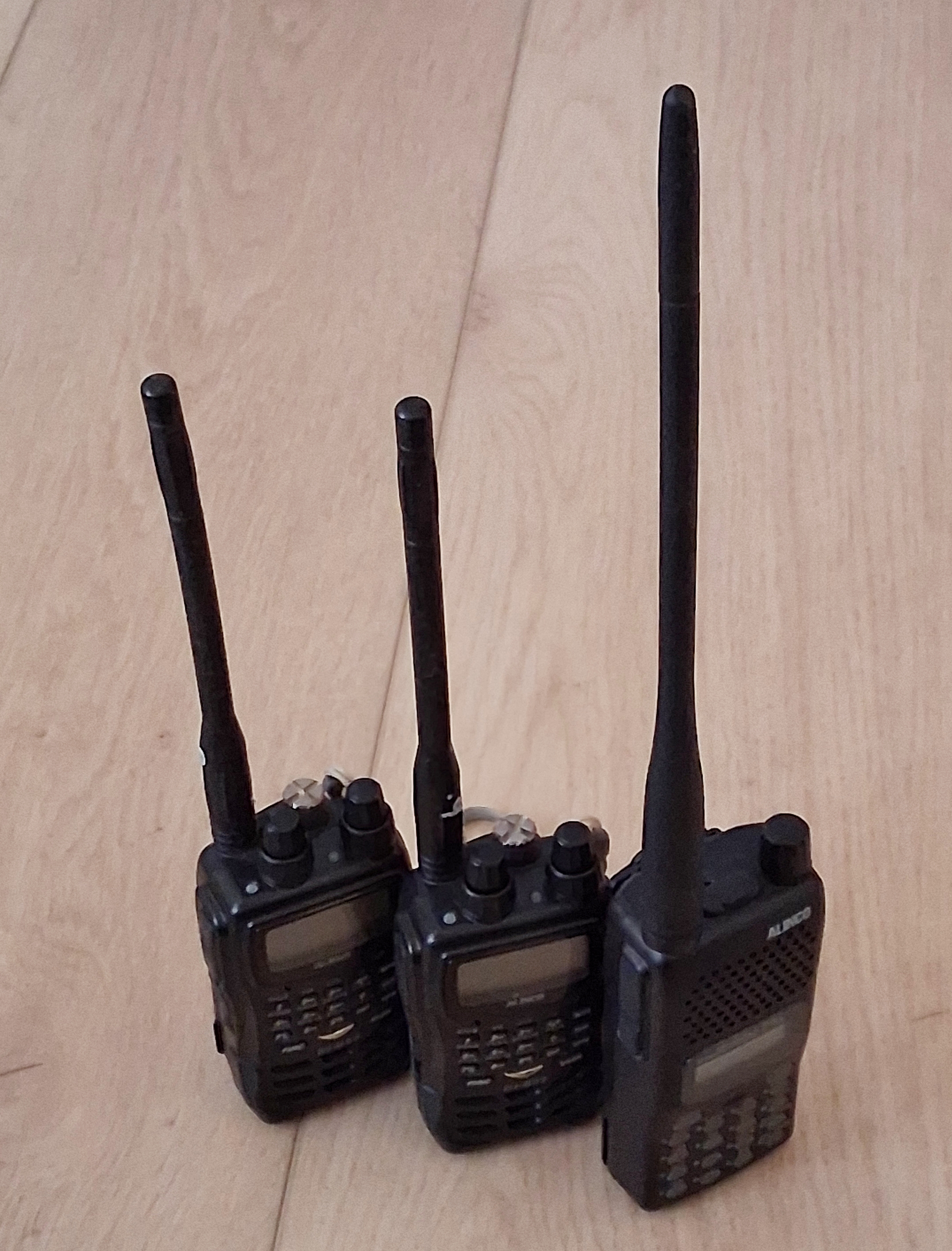
HAM
RADIO THEN AND NOW
When I first got on the air in
1957, ham radio was barely 50 years old. Activity patterns were
about to change dramatically as technology advanced. Many
modern uses of radio did not exist in the early days. The 1950s
saw the near abandonment of amplitude modulation (AM) and its
replacement by frequency modulation (FM) and single sideband (SSB).
Radio pioneer Edwin Howard Armstrong famously demonstrated the
superiority of FM over AM for the broadcasting of music because of
its immunity to the noise (static) that plagued AM listeners.
FM replaced AM as the leading source of broadcast music after World
War II. By the 1950s it proved its superiority for voice use as
well. (Caption
for picture at right: here are three handy-talkies.
Either of the left two covers 222 and 902 MHz. The largest one
on the right covers 144, 432 and 1296 MHz, giving the user all
amateur bands in that portion of the spectrum).
SSB had been in use for
expensive point-to-point voice communication systems in the 1930s.
It was clearly superior to AM for long-distance communications.
SSB got its name from the fact that it is possible to suppress one of
the two voice sidebands and all of the carrier (the part of an AM
signal you can hear over the air), leaving about four times the power
and half the bandwidth in the remaining signal. It was also
shown quickly that a given transmitter could be operated at several
times its AM power because of the low duty cycle of SSB.
Perhaps the biggest change in amateur radio that came with the advent of SSB was the near end of cross-band voice operation in which the two stations operate on very different frequencies. During the postwar era most other countries allowed voice operation on many more frequencies than the U.S. did. For a U.S station hoping to contact other countries on phone, that meant transmitting in the very crowded U.S. phone bands and hoping overseas stations would abandon their relative tranquility and tune up into the bedlam of the American phone bands. It made many U.S. hams feel like second-class people. Some foreign hams liked it because they could talk to each other without interference from U.S. hams. The advent of transceivers changed that. Many early transceivers had only limited cross-band capability--unlike modern transceivers with A-B switches to allow instant transmitting on one frequency and listening on a different frequency. Many overseas operators began moving up to the American phone bands, making the world a more equal place. Also, the rules were changed by “incentive licensing” to allow U.S. hams with extra class licenses to use some of the same frequencies as hams in the rest of the world. But incentive licensing also deprived general class licensees of frequencies they had traditionally used, causing controversy in ham radio in the late 1960s.
Hams
in rare countries will sometimes say something like "listening
up three" to indicate they want callers to stay off the rare
station's transmit frequency to reduce interference from
“pile-ups” of
hams all calling the same rare station.
Most operators comply with such instructions; those who don't get
called unprintable names. Another factor
that made the American
phone bands
seem less crowded
was the advent of
SSB. SSB signals have a bandwidth of less than 3 kHz (AM
signals are about 10 kHz wide). Even more important is that
with the carrier suppressed, SSB signals generate none of the
screeches and squeals made when two carriers are on adjacent
channels.
Postwar advances in technology
also made
SSB affordable to ham radio operators. Manufacturers began
making equipment for the amateur market in the 1950s. But when
I operated in "phone sweepstakes" in 1959 almost all of the
activity was still on traditional AM. I finished second in the
Los Angeles section without even owning a transmitter capable of
SSB. However, by 1965 almost all activity was on SSB, not AM.
AM transmitters came to be called "boat anchors" because
they had
modulation transformers not needed for SSB.
VACUUM
TUBES, TRANSISTORS AND CHIPS
No change in radio technology
was more profound than the transition from vacuum tubes to
transistors and then to chips. Vacuum tubes were large, power-hungry
glass objects that glowed in the dark. Tubes helped the radio
pioneers make global two-way contacts in the early days and they also
made my first station work. The 1957 photo of my station showed
nothing that didn't use vacuum tubes. That was the end of an
era. I bought my first transistor radio in 1959. It
covered the AM broadcast band and several shortwave bands but it
could not copy SSB or Morse code signals. That radio
quickly became obsolete.
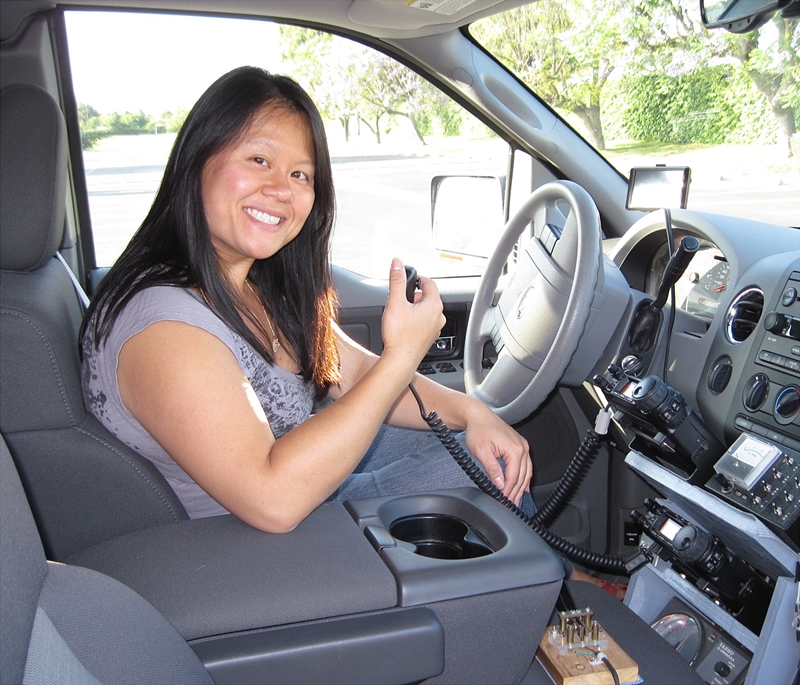 By the mid-1960s several manufacturers were making all-solid-state
transceivers (radios that have a transmitter and a receiver in one
box). Although some still used vacuum tubes during this
transitional period, the trend was clearly away from tubes.
Manufacturers were not only making transistor radios but also radios
using large scale integration. LSI involves combining many
transistors of various types in one small package. Modern
"chips" have hundreds or thousands of transistors that all
function together to make a cellphone or a car work as intended.
That radio quickly became obsolete.
By the mid-1960s several manufacturers were making all-solid-state
transceivers (radios that have a transmitter and a receiver in one
box). Although some still used vacuum tubes during this
transitional period, the trend was clearly away from tubes.
Manufacturers were not only making transistor radios but also radios
using large scale integration. LSI involves combining many
transistors of various types in one small package. Modern
"chips" have hundreds or thousands of transistors that all
function together to make a cellphone or a car work as intended.
That radio quickly became obsolete.
By the 1970s vacuum tube and
transistor radios had been replaced. The result was
transceivers and cellphones that were tiny and powered by tiny
batteries. It's been said that if a modern cellphone had to be
made with vacuum tubes, it would fill a large room all by itself and
it would need heavy cables for power. Besides, vacuum tubes
could never do many of the things cellphones do because of their
frequency limitations. (Caption
for photo at right: Carrie, W6TAI, operates N6NB's VHF
contest rover setup. This shows equipment that was routine by
the 2000s but would have been revolutionary before the solid state
era. There are two transceivers that both cover 1.8 to 432 MHz
on SSB, AM and FM plus Morse code with up to 100 watts output.
On the right there is a switchbox that controls transverters for all
microwave bands up to 10 GHz. Both W6TAI and N6NB won
VHF+ contests using this station).
SATELLITE
COMMUNICATIONS
Another notable example of
evolving technology has been the use of ham radio communications
satellites. Soon after the launch of Sputnik by the
Soviet Union in late 1957, hams envisioned satellites dedicated to
use by hams. AMSAT (the Amateur Radio Satellite Corporation)
was founded in 1959 and the first amateur satellite was launched
three years later. A continuing problem for AMSAT is that
launching a satellite is expensive even if the satellite was designed
and built with volunteer labor. Hams have been able to obtain
unsold payload space on rockets for free but that is still a
challenge.
One way to spot a satellite
ground station is to look for its distinctive antennas. The
antennas will often be pointed upward and designed to track a
satellite as it passes across the sky. The antennas will often
be "cross polarized" with a set of horizontal rod
elements and a second
set of vertical elements. This is done because the ground
station must be able to track the satellite as it spins and is
affected by its polarization. An antenna with horizontal
elements is much weaker if it is trying to contact a station using
vertical elements. The solution is for the earth station to
feed half of its power to vertical elements and the other half to
horizontal elements. That is not a perfect solution
because there are also polarization shifts as a radio signal passes
through the earth's atmosphere. Contacts with satellites or the
International Space Station are a common feature in school
demonstrations of ham radio scheduled in advance by teachers and
coordinated by ham radio organizations worldwide.
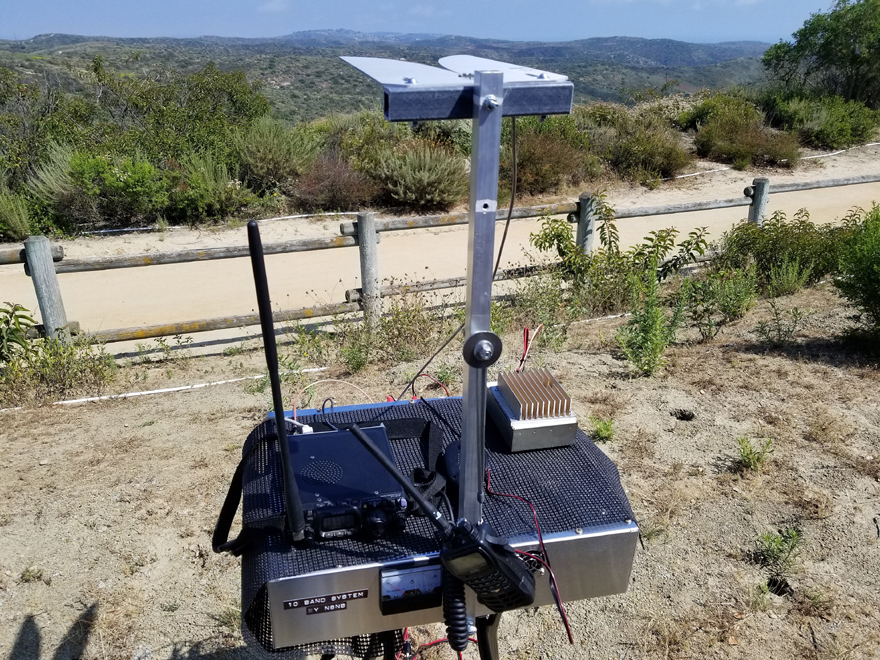
FIELD
DAY
Another
new thing is the rapid growth of "Field Day". Field
Day is mainly a weekend outing in late June that involves setting up
a station (including antennas) in a park or on a mountaintop and then
using off-the-grid power sources like generators or solar panels to
run the station. On Sunday afternoon the antennas usually
come down with dignity--except when Murphy's Law applies (it
says anything that can go wrong will go wrong). Clubs and
other groups report having a total of 30,000 or more people
participating in Field Day. Some are mainly chefs who serve
meals or antenna-builders whose work is done before the actual
operating begins. Some groups report that a few members do
everything. The operating is not a contest, although it sounds
like one. Some clubs have a turnout of more than 50
people; others
are much smaller. There are also categories for people
operating from home or a car. (Caption
for photo at left: this is a complete microwave station with
amplifiers from 902 to 10 GHz that fits in a carry-aboard suitcase
and has only one antenna: a Vivaldi that is rated around 11 dbi
gain from 800 MHz to over 10 GHz).
THE
INTERNET AND AMATEUR RADIO
Obviously, use of the Internet
is another new reality. Some hams spend more time talking to
ham friends online than on the air. Most Internet sites have
interest groups for hams and ham radio websites are everywhere.
Some repeaters are linked to the Internet, allowing users of
hand-held radios in California to chat with similarly equipped
stations in Europe, for example.
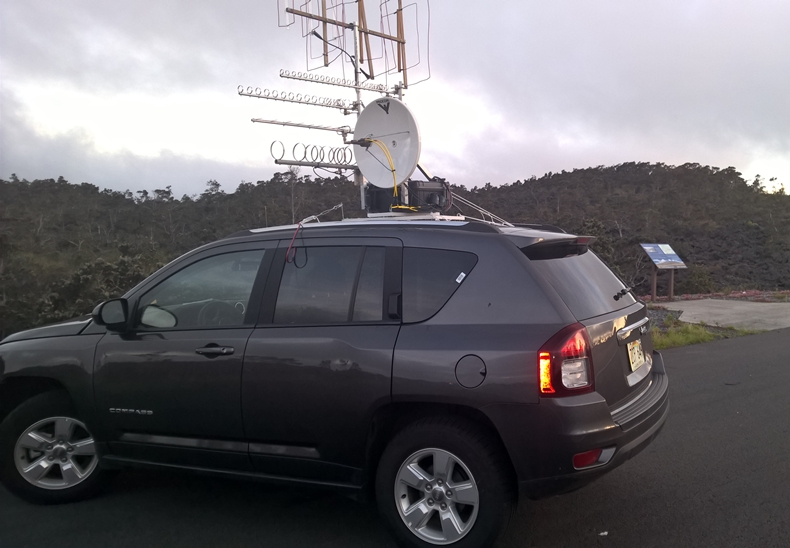
ARRL has a major Internet
presence, including ARRL.org. It also has "logbook of the
world" that makes it easy to win awards--provided the ham on the
other end of each contact also uploads a log. ARRL.org has many
features,
including news, technical content, and contest results. Many
other hams have websites. Mine is N6NB.com. (Caption
for the photo at right: This
is the actual Hawaiian site from which I worked the mainland on six
bamds, setting new DX records on 902 MHz, and 2.3 and 3.4 GHz, using
the tropospheric duct that enables Iong distance contacts on what are
normally local bands. I flew to the big island of Hawaii six
times in 2014-2016, hauling three overweight suitcases and spending
extra money for luggage. A key factor was setting up a beacon
at home on 222 MHz. I rented a car and outfitted it as shown
here to scout for the best sites. I found that this site at
5,000' elevation on the Daniel Inouye Highway was better than many
higher sites when I was there (that varies). Special thanks to
W6IT for operating my home station and taking my rover truck further
inland to break the 902 record).
IN
CONCLUSION
Over the last 68 years I've
experienced many of the old and new amateur radio events and
activities. It has been my pleasure to watch it all happen.
I started when all radio equipment had vacuum tubes and saw the
arrival of ham gear linked to the Internet.
I would like to thank my
spouse, Carrie Tai, W6TAI, and my sister in law, Marie Tai, W1TAI,
for their support. I also had help from hundreds of other
people, both hams and people who never held a call sign. Some
of them motivated me or helped me to publish 20 editions of a
university textbook, "Major Principles of Media Law".
Others politely listened to my annual talks about changes in the law
affecting college student media at the Morro Bay faculty retreats of
the Journalism Association of Community Colleges. Then there
were hams who mentored me through several generations of amateur
radio.
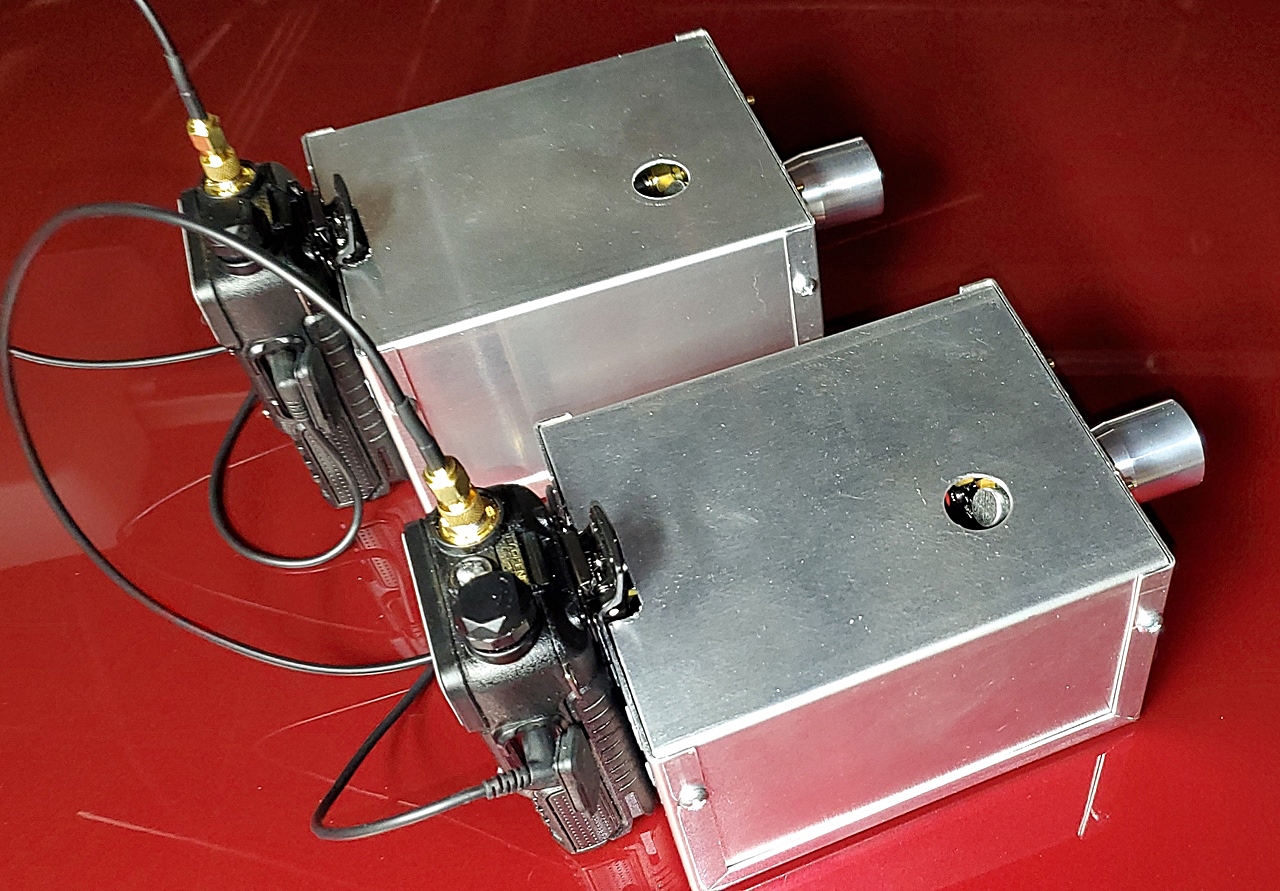

There
are many new frontiers in amateur radio today, One of them is
to move up to ever-higher frequencies. Now that frontier is at
least 122 GHz. Using a chip designed for auto collision
avoidance radar, VK3CV and colleagues in Australia designed and had a
company in China make boards to program the radar chip and move its
frequency into the amateur band at 122 GHz. Hundreds of these
were sold to hams around the world. Many hams who were
interested bought two or more boards to contact nearby hams.
Because the Australians were only providing the boards, it was up to
hams and their friends to build the package. My goal was to
have small complete stations--including batteries--that could be held
in one hand, placed on a table or mounted on a tripod. I used
handy-talkies for the IF (intermediate frequency) to keep the units
as small as possible. How far can two radio amateurs
communicate on 122 GHz? The record is about 120 km between two
mountain peaks overlooking the Silicon Valley. They used dish
antennas and had near-ideal conditions (such as very low water vapor
losses). The built-in horn antennas (visible in the photos) are
tiny but deliver 21 dB. gain at a frequency where a wavelength is
only 2.5 millimeters--less than one tenth of an
inch. At the other end of the spectrum, radio amateurs are making contacts at 2200 meters (135 kHz).
-Wayne Overbeck,
N6NB